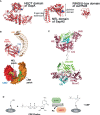Interesting Biochemistries in the Structure and Function of Bacterial Effectors
- PMID: 33718265
- PMCID: PMC7943720
- DOI: 10.3389/fcimb.2021.608860
Interesting Biochemistries in the Structure and Function of Bacterial Effectors
Abstract
Bacterial effector proteins, delivered into host cells by specialized multiprotein secretion systems, are a key mediator of bacterial pathogenesis. Following delivery, they modulate a range of host cellular processes and functions. Strong selective pressures have resulted in bacterial effectors evolving unique structures that can mimic host protein biochemical activity or enable novel and distinct biochemistries. Despite the protein structure-function paradigm, effectors from different bacterial species that share biochemical activities, such as the conjugation of ubiquitin to a substrate, do not necessarily share structural or sequence homology to each other or the eukaryotic proteins that carry out the same function. Furthermore, some bacterial effectors have evolved structural variations to known protein folds which enable different or additional biochemical and physiological functions. Despite the overall low occurrence of intrinsically disordered proteins or regions in prokaryotic proteomes compared to eukaryotes proteomes, bacterial effectors appear to have adopted intrinsically disordered regions that mimic the disordered regions of eukaryotic signaling proteins. In this review, we explore examples of the diverse biochemical properties found in bacterial effectors that enable effector-mediated interference of eukaryotic signaling pathways and ultimately support pathogenesis. Despite challenges in the structural and functional characterisation of effectors, recent progress has been made in understanding the often unusual and fascinating ways in which these virulence factors promote pathogenesis. Nevertheless, continued work is essential to reveal the array of remarkable activities displayed by effectors.
Keywords: bacterial effectors; host-pathogen; pathogenesis; protein organization; secretion systems; structure-function.
Copyright © 2021 Mak and Thurston.
Conflict of interest statement
The authors declare that the research was conducted in the absence of any commercial or financial relationships that could be construed as a potential conflict of interest.
Figures



Similar articles
-
Common themes in the design and function of bacterial effectors.Cell Host Microbe. 2009 Jun 18;5(6):571-9. doi: 10.1016/j.chom.2009.04.008. Cell Host Microbe. 2009. PMID: 19527884 Free PMC article. Review.
-
Exploitation of eukaryotic subcellular targeting mechanisms by bacterial effectors.Nat Rev Microbiol. 2013 May;11(5):316-26. doi: 10.1038/nrmicro3009. Nat Rev Microbiol. 2013. PMID: 23588250 Free PMC article. Review.
-
Evolution of prokaryotic and eukaryotic virulence effectors.Curr Opin Plant Biol. 2008 Aug;11(4):412-9. doi: 10.1016/j.pbi.2008.05.001. Epub 2008 Jun 26. Curr Opin Plant Biol. 2008. PMID: 18585954 Review.
-
An Overview of Anti-Eukaryotic T6SS Effectors.Front Cell Infect Microbiol. 2020 Oct 19;10:584751. doi: 10.3389/fcimb.2020.584751. eCollection 2020. Front Cell Infect Microbiol. 2020. PMID: 33194822 Free PMC article. Review.
-
A systematic analysis of the RNA-targeting potential of secreted bacterial effector proteins.Sci Rep. 2017 Aug 24;7(1):9328. doi: 10.1038/s41598-017-09527-0. Sci Rep. 2017. PMID: 28839189 Free PMC article.
Cited by
-
Short Linear Motifs (SLiMs) in "Core" RxLR Effectors of Phytophthora parasitica var. nicotianae: a Case of PpRxLR1 Effector.Microbiol Spectr. 2022 Apr 27;10(2):e0177421. doi: 10.1128/spectrum.01774-21. Epub 2022 Apr 11. Microbiol Spectr. 2022. PMID: 35404090 Free PMC article.
-
The role of the glycome in symbiotic host-microbe interactions.Glycobiology. 2023 Dec 30;33(12):1106-1116. doi: 10.1093/glycob/cwad073. Glycobiology. 2023. PMID: 37741057 Free PMC article. Review.
-
Intrinsically Disordered Proteins: An Overview.Int J Mol Sci. 2022 Nov 14;23(22):14050. doi: 10.3390/ijms232214050. Int J Mol Sci. 2022. PMID: 36430530 Free PMC article. Review.
-
Exploiting Bacterial Effector Proteins to Uncover Evolutionarily Conserved Antiviral Host Machinery.bioRxiv [Preprint]. 2024 Jan 30:2024.01.29.577891. doi: 10.1101/2024.01.29.577891. bioRxiv. 2024. Update in: PLoS Pathog. 2024 May 16;20(5):e1012010. doi: 10.1371/journal.ppat.1012010. PMID: 38352400 Free PMC article. Updated. Preprint.
-
Exploiting bacterial effector proteins to uncover evolutionarily conserved antiviral host machinery.PLoS Pathog. 2024 May 16;20(5):e1012010. doi: 10.1371/journal.ppat.1012010. eCollection 2024 May. PLoS Pathog. 2024. PMID: 38753575 Free PMC article.
References
Publication types
MeSH terms
Substances
Grants and funding
LinkOut - more resources
Full Text Sources
Other Literature Sources

